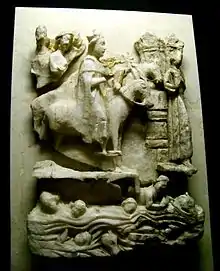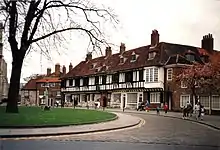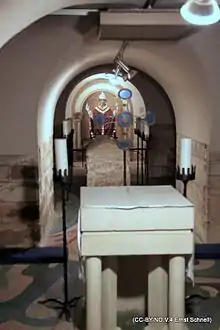William of York
William of York (late 11th century – 8 June 1154)[lower-alpha 1] was an English priest, and unusually, twice Archbishop of York, before and after his rival Henry Murdac. He was thought to be related to King Stephen of England, who helped to secure his election to York after several candidates had failed to gain papal confirmation. William faced opposition from the Cistercians, who after the election of the Cistercian Pope Eugene III, had William deposed in favour of the Cistercian Murdac. From 1147 until 1153, William worked to secure his restoration to York, which he finally achieved after the deaths of Murdac and Eugene III. He did not hold the see long, dying shortly after his return, allegedly poisoned with the chalice he used to celebrate Mass.[3] Miracles began to be reported at his tomb from 1177 onwards. He was canonised in 1226.
William of York | |
|---|---|
| Archbishop of York | |
| Elected | January 1141 20 December 1153 |
| Installed | 1141 |
| Term ended | Deprived 1147 8 June 1154 |
| Predecessor | Henry de Sully Henry Murdac |
| Successor | Henry Murdac Roger de Pont L'Évêque |
| Other posts | Treasurer of York |
| Orders | |
| Consecration | 26 September 1143 |
| Personal details | |
| Born | Late 11th century |
| Died | 8 June 1154 York, England |
| Buried | York Minster |
| Parents | Herbert of Winchester Emma |
| Sainthood | |
| Feast day | 8 June |
| Venerated in | Roman Catholic Church |
| Canonized | 18 March 1226 Rome by Pope Honorius III |
| Shrines | York Minster |
.svg.png.webp)
Early life
Born William fitzHerbert in York,[4] William was the son of Herbert of Winchester, or Herbert fitzAlberic,[5] chancellor and treasurer of King Henry I.[6] Most sources say his mother was Emma, half-sister of King Stephen and Henry of Blois, Bishop of Winchester,[7] and that she was an illegitimate daughter of Stephen II, Count of Blois, Stephen's father.[8] New research, however, suggests that Emma might have been a daughter of Hunger fitzOdin, who held lands in Dorset in the Domesday survey.[4] William was born sometime before the 1090s, but the date of birth is unknown.[4]
William held the prebendary of Weighton in the diocese of Yorkshire between 27 June 1109 and 24 February 1114.[9] Sometime between 1109 and 1114 he was appointed Treasurer of York.[7] He was also appointed archdeacon of the East Riding of Yorkshire at an unknown date between 1125 and 1133.[10] The influence of his rich and powerful father, who had many landholdings in Yorkshire, may have been of benefit in gaining him these offices at a relatively early age.[11] William apparently held both of these offices until his election as archbishop.[10] Serving under Archbishop Thurstan of York, William became involved in Thurstan's dispute with King Henry I after Henry demanded that the Archbishops of York should accept subordination to the Archbishops of Canterbury. William accompanied Thurstan into exile in Europe and on embassies to the papal court.[12] Reconciliation with Henry allowed a return to York in 1121. A papal ruling in favour of the independence of the Archbishops of York was finally delivered in 1127.[13]
Election problems
In January 1141 William was elected Archbishop of York.[14] Originally, the cathedral chapter of York had elected Waltheof in 1140, but that election was set aside because one of Waltheof's supporters had made an uncanonical gift[lower-alpha 2] to secure Waltheof's election. Then Henry of Blois tried to secure the see for Henry de Sully, another nephew of Stephen and Henry's. Sully's election was opposed by Pope Innocent II,[15] who refused to confirm him as archbishop while he retained his post as Abbot of Fécamp.[16] It was only at a third election, held in January 1141, that William was selected. Whether he had been a candidate in the previous two elections is unknown.[15]
The election was opposed by the Cistercian monasteries of Yorkshire, and by the archdeacons of York.[17] The Cistercians opposed on the grounds that the Second Lateran Council in 1139 had given the religious houses of a diocese the right to participate in the election of the bishop.[18] Theobald of Bec, the Archbishop of Canterbury, refused to recognise William's election due to allegations of simony (acquisition of church positions by bribery), and of interference by King Stephen.[19] In 1143, Pope Innocent II ruled that William could be confirmed in office if he swore under oath that the allegations were false. After he swore the oath, Henry of Blois, who was also papal legate, found William innocent, and he was consecrated as archbishop on 26 September 1143.[7]
First archiepiscopate and deposition

As archbishop, William undertook a number of ecclesiastical reforms, and became popular with the people of York. However, he still needed a pallium, the sign of an archbishop's authority from the pope, which he had not yet received. The Cistercians, who were still adamantly opposed to his being archbishop, were determined to prevent his receiving it. William travelled to Rome in an attempt to obtain the pallium. The election of Pope Eugene III, a Cistercian, in 1145, was a setback for his cause.[20] Bernard of Clairvaux, the famous Cistercian abbot and religious leader, exerted all his influence to ensure William's suspension, sending a series of complaints to the new pope that William had been intruded by secular powers into the see, that he was oppressing the Cistercian monasteries and that he had irregularly appointed William of St. Barbara as Dean of York. In the winter of 1145–46 Eugene re-examined the case, declared that William had not been validly consecrated, and suspended him from office.[21] William was required to obtain an in-person refutation of the old charges by William of St Barbara, who was now the Bishop of Durham.[7][17]
While awaiting the final decision in his case, William took up residence with one of his friends, Roger II, King of Sicily.[21] Hearing of his suspension, some of William's supporters in York launched a damaging attack upon Fountains Abbey which destroyed many of the buildings.[22] William was formally deposed as archbishop by Eugene in early 1147 and the deposition was confirmed at the Council of Reims on 21 March 1148. Another election to York was held, and the candidates included Hilary of Chichester, who was the king's candidate, and Henry Murdac, the Cistercian abbot of Fountains Abbey. Murdac's supporters included the Cistercians and most of the clergy of the diocese, including William's former ally, William of St Barbara. Both sides appealed to the pope, and the pope confirmed Murdac as the successful candidate.[7][17] William then returned to Winchester, the city he had left forty years earlier to begin his career in York.[23]
Second archiepiscopate
King Stephen refused to accept William's deposition and the appointment of Murdac, and prevented Murdac from taking up residence in York. Stephen probably wished to trade recognition of Murdac for support for his son Eustace. Stephen was trying to secure the coronation of Eustace as his successor during his own lifetime, to defeat the rival claims to the throne of Henry of Anjou.[24][lower-alpha 3] Within a few years both Murdac and the pope had died, so William travelled to Rome to plead with the new pope, Anastasius IV, for restoration to office. The pope concurred, and William's reappointment was confirmed on 20 December 1153.[7][25] On his return to York, while crossing the Ouse Bridge in York in triumphal procession, the bridge collapsed, yet no one was killed.[26]
Death and sainthood

After less than a month back in York, William died, on 8 June 1154,[14] allegedly due to poison administered in the chalice at Mass.[25] One of William's clerks accused Osbert de Bayeux, an archdeacon of York, of the murder, and Osbert was summoned before the king to be tried at the royal court. Stephen died before the trial could take place.[27] William was buried in York Minster[28] and within a few months of his death, miracles were attributed to his intervention and a sweet smell came from his tomb when it was damaged during a fire. Nor was the body decayed or burnt in the fire.[29] Pope Honorius III then ordered an investigation into the miracles. In 1226, he was canonised in Rome by Pope Honorius III.[29]
William's feast day is celebrated on 8 June, the day of his death.[30] Although his veneration was largely localised in York, among his devotees was Margery Kempe (1373–1438) of King's Lynn in Norfolk, who "cried copiously" before his tomb.[3] Traditional iconography and windows often depict William's crossing of the Tweed; some iconography shows him crossing in a boat. William's coat of arms is blazoned: Or, seven mascles Gules, 3, 3 and 1. This actual shield at one time hung on the west wall of St Wilfrid's Church, Bognor Regis.[31] St William's College, which was named for him is next to York Minster. It was established between 1465 and 1467 with the permission of King Edward IV as the home for chantry priests of the Cathedral.[32] His remains were rediscovered in the 1960s and are now in the crypt at York Minster.[33]

Notes
- Also known as William FitzHerbert, William I FitzHerbert and William of Thwayt.
- Known to non-clergy as a bribe.
- Henry eventually became King Henry II of England after the death of Eustace and Stephen.
Citations
- Drake, Francis (1736). Eboracum: or the History and Antiquities of the City of York. London: William Bowyer. p. 529.
- (shown there with 10 mascles, see imageFile:Pope Celestine, St William and an unidentified Prelate, East Window, York Minster.jpg
- Emma J. Wells, "Making Sense of Things", History Today, Vol 69, No. 5 (May 2019), p. 40.
- Burton "William of York" "Oxford Dictionary of National Biography"
- Keats-Rohan Domesday Descendants pp. 151–152
- Hollister "Origins of the English Treasury" English Historical Review p. 268.
- Greenway Fasti Ecclesiae Anglicanae 1066–1300: Volume 6: York: Archbishops.
- Davis King Stephen pp. 172–173.
- Greenway Fasti Ecclesiae Anglicanae 1066–1300: Volume 6: York: Prebendaries: Weighton.
- Greenway Fasti Ecclesiae Anglicanae 1066–1300: Volume 6: York: Archdeacons: East Riding
- Norton Saint William of York pp. 10–16.
- Norton Saint William of York pp. 34–37.
- Norton Saint William of York p. 61.
- Fryde, et al. Handbook of British Chronology p. 281.
- Crouch Reign of King Stephen p. 304.
- Norton Saint William of York p. 81.
- Barlow English Church 1066–1154 p. 98.
- Burton Monastic and Religious Orders p. 77.
- Poole Domesday Book to Magna Carta p. 191.
- Davis King Stephen pp. 97–99.
- Norton Saint William of York p. 118.
- Norton Saint William of York p. 120
- Norton Saint William of York p. 124.
- Davis King Stephen p. 103.
- Barlow English Church 1066–1154 p. 102.
- Walsh New Dictionary of Saints pp. 627–628.
- Richardson and Sayles Governance of Mediaeval England p. 288.
- Norton Saint William of York p. 145
- Norton Saint William of York p. 149.
- Manser (ed.) "Dictionary of Saints," p. 300.
- "Heraldry associated with St Wilfrid (and St William of York)" St Wilfrid's Church
- Page (ed.) "Collegiate Churches: York (including York Minster)" History of the County of York: Volume 3 pp. 375–386.
- "York Minster FAQs, Question 8" York Minster.
References
- Burton, Janet (1994). Monastic and Religious Orders in Britain: 1000–1300. Cambridge Medieval Textbooks. Cambridge UK: Cambridge University Press. ISBN 0-521-37797-8.
- Burton, Janet (2004). "William of York (d. 1154)" ((subscription or UK public library membership required)). Oxford Dictionary of National Biography. Oxford University Press. doi:10.1093/ref:odnb/9606. Retrieved 17 March 2008.
- Crouch, David (2000). The Reign of King Stephen: 1135–1154. New York: Longman. ISBN 0-582-22657-0.
- Davis, R. H. C. (1990). King Stephen 1135–1154 (Third ed.). New York: Longman. ISBN 0-582-04000-0.
- Fryde, E. B.; Greenway, D. E.; Porter, S.; Roy, I. (1996). Handbook of British Chronology (Third Edition, revised ed.). Cambridge: Cambridge University Press. ISBN 0-521-56350-X.
- Greenway, Diana E. (1999). Fasti Ecclesiae Anglicanae 1066–1300: Volume 6: York: Archbishops. Institute of Historical Research. Retrieved 16 March 2008.
- Greenway, Diana E. (1999). Fasti Ecclesiae Anglicanae 1066–1300: Volume 6: York: Archdeacons: East Riding. Institute of Historical Research. Retrieved 16 March 2008.
- Greenway, Diana E. (1999). Fasti Ecclesiae Anglicanae 1066–1300: Volume 6: York: Prebendaries: Weighton. Institute of Historical Research. Retrieved 16 March 2008.
- "Heraldry associated with St. Wilfrid (& St. William of York)". St. Wilfrid's Church. Retrieved 16 March 2008.
- Hollister, C. W. (April 1978). "The Origins of the English Treasury". The English Historical Review. 93 (367): 262–275. doi:10.1093/ehr/XCIII.CCCLXVII.262. JSTOR 567061.
- Keats-Rohan, K. S. B. (1999). Domesday Descendants: A Prosopography of Persons Occurring in English Documents, 1066–1166: Pipe Rolls to Cartae Baronum. Ipswich, UK: Boydell Press. ISBN 0-85115-863-3.
- Manser, Martin, ed. (2004). Dictionary of Saints. New York: Collins. ISBN 0-00-716950-7.
- Norton, Christopher (2006). St William of York. York: York Medieval Press. ISBN 1-903153-17-4.
- Page, William, ed. (1974). "Collegiate Churches: York (Including York Minster)". A History of the County of York: Volume 3. Victoria County History. Retrieved 17 March 2008.
- Poole, Austin Lane (1955). From Domesday Book to Magna Carta, 1087–1216 (Second ed.). Oxford: Clarendon Press. ISBN 0-19-821707-2.
- Richardson, H. G.; Sayles, G. O. (1963). The Governance of Mediaeval England: From the Conquest to Magna Carta. Edinburgh: Edinburgh University Press. OCLC 504298.
- Walsh, Michael J. (2001). Dictionary of Christian Biography. Collegeville, MN: Liturgical Press. ISBN 0-8146-5921-7.
- "York Minster FAQs Question 8". York Minster. Retrieved 16 March 2008.
Further reading
- Knowles, David (1936). "The Case of Saint William of York". Cambridge Historical Journal. 5 (2): 162–177. doi:10.1017/S1474691300001311. JSTOR 3020721.
- Knowles, David (1936). "The Case of Saint William of York: Appendix". Cambridge Historical Journal. 5 (2): 212–214. doi:10.1017/S1474691300001347. JSTOR 3020724.
- Morey, Adrian (1952). "Canonist Evidence in the Case of St William of York". Cambridge Historical Journal. 10 (3): 352–353. doi:10.1017/S1474691300002997. JSTOR 3021118.
- Poole, R. L. (April 1930). "The Appointment and Deprivation of St. William, Archbishop of York". The English Historical Review. 45: 273–81. doi:10.1093/ehr/XLV.CLXXVIII.273. JSTOR 553158.
- Talbot, C. H. (1950). "New Documents in the Case of Saint William of York". Cambridge Historical Journal. 10 (1): 1–15. doi:10.1017/S1474691300002651. JSTOR 3021066.
- White, G. H. (1932). "The Parentage of Herbert the Chamberlain". Notes and Queries: 439–441, 453–455. doi:10.1093/nq/CLXII.jun18.439.
| Catholic Church titles | ||
|---|---|---|
| Preceded by Thurstan |
Archbishop of York 1143–1147 |
Succeeded by Henry Murdac |
| Preceded by Henry Murdac |
Archbishop of York 1153–1154 |
Succeeded by Roger de Pont L'Évêque |